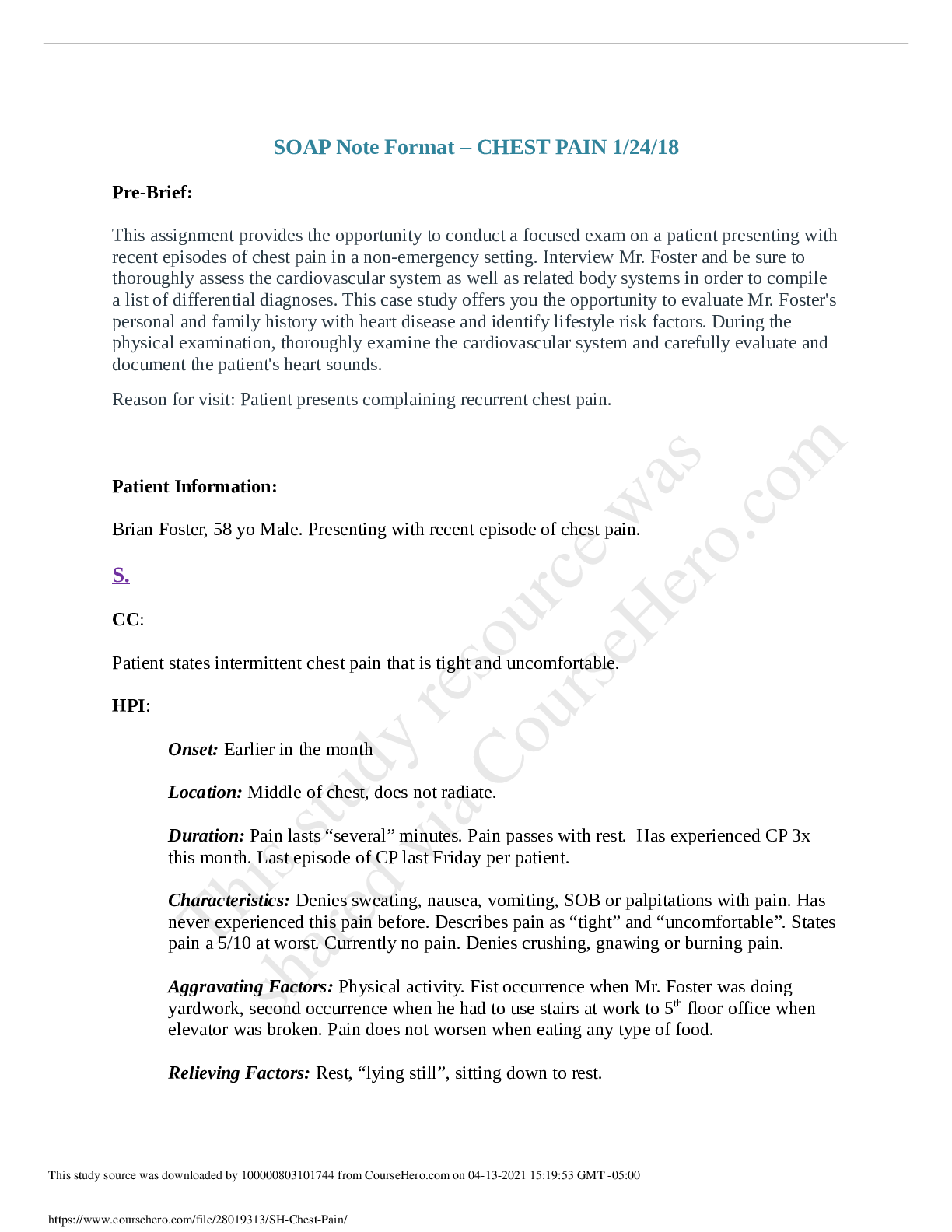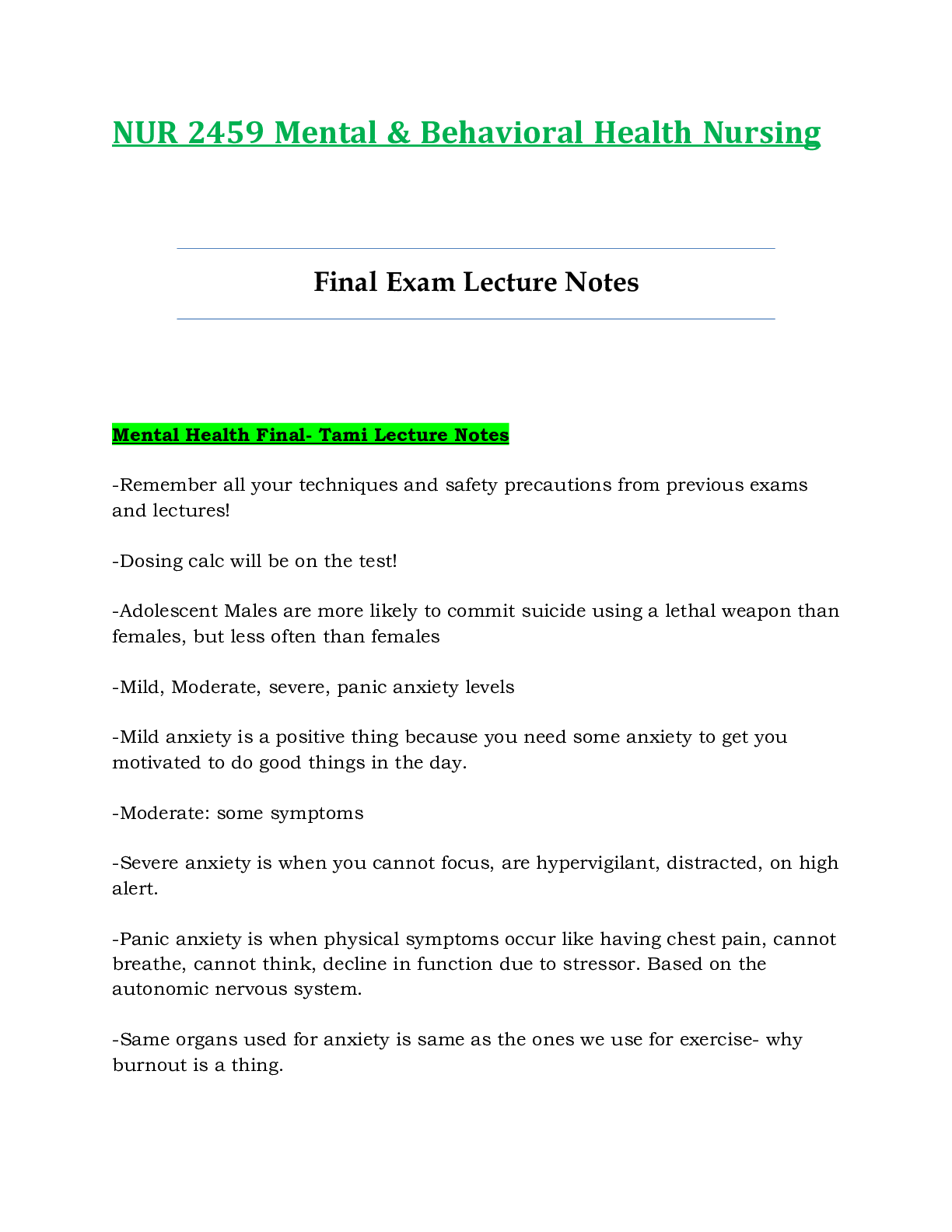Anatomy > Class Notes > ANATOMY AND PHYSIOLOGY WITH LAB (All)
ANATOMY AND PHYSIOLOGY WITH LAB
Document Content and Description Below
LEARNING MODULE INFORMATION I. Course Code SEM 301c II. Course Title Anatomy and Physiology with Laboratory III. Module Number 01 IV. Module Title Level of Organization and Life Functions V. Over ... view of the Module Human beings are arguably the most complex organisms on this planet. Imagine billions of microscopic parts, each with its own identity, working together in an organized manner for the benefit of the total being. The human body is a single structure but it is made up of billions of smaller structures of four major kinds: cells, tissues, organs, and organ systems. VI. Module Outcomes As for the outcome of the module, you are expected to do research, take a quiz in varied types and do enrichment activities that will develop critical thinking skills. Experimental reports are also required. VII. General Instructions The module covers the lessons for the Preliminary period of the course. The assessment part found at the end of the module maybe composed of varied types of questions. It may take the form of matching type, multiple choice, compare and contrast, filling the table with the correct data and/or essay and problem solving. Answers must be written in a short bond paper. Module 01 should be named, stapled, and properly labeled with the Lesson No.(topic), Exercise, Assessment, or Enrichment Activity. Do not write at the back of the bond paper. Please note that there will be point deductions for not following instructions. You are advised to practice honesty as you work with all the outputs. If found having a totally copied output/same answers you will be asked to repeat your submittals or get a failing grade for cheating. Good luck. 1 Learning Module on Anatomy and Physiology Lesson 1: Overview of Anatomy and Physiology Objectives: Compare and contrast anatomy and physiology, including their specializations and methods of study Discuss the fundamental relationship between anatomy and physiology Human anatomy - is the scientific study of the body’s structures. Some of these structures are very small and can only be observed and analyzed with the assistance of a microscope. Other larger structures can readily be seen, manipulated, measured, and weighed. - The word “anatomy” comes from a Greek root that means “to cut apart.” Historical Development - Human anatomy was first studied by observing the exterior of the body and observing the wounds of soldiers and other injuries. - Later, physicians were allowed to dissect bodies of the dead to augment their knowledge. When a body is dissected, its structures are cut apart in order to observe their physical attributes and their relationships to one another. Dissection is still used in medical schools, anatomy courses, and in pathology labs. - In order to observe structures in living people, however, a number of imaging techniques have been developed. These techniques allow clinicians to visualize structures inside the living body such as a cancerous tumor or a fractured bone. Areas of Specialization 1. Gross anatomy - is the study of the larger structures of the body, those visible without the aid of magnification (Figure 1a). Macro– means “large,” thus, gross anatomy is also referred to as macroscopic anatomy. 2. Microscopic anatomy - is the study of structures that can be observed only with the use of a microscope or other magnification devices. - Microscopic anatomy includes cytology, the study of cells and histology, the study of tissues. As the technology of microscopes has advanced, anatomists have been able to observe smaller and smaller structures of the body, from slices of large structures like the heart, to the three-dimensional structures of large molecules in the body Two general approaches to the study of the body’s structures: 1. Regional anatomy is the study of the interrelationships of all of the structures in a specific body region, such as the abdomen. Studying regional anatomy helps us 2 Learning Module on Anatomy and Physiology 2. appreciate the interrelationships of body structures, such as how muscles, nerves, blood vessels, and other structures work together to serve a particular body region. 3. Systemic anatomy is the study of the structures that make up a discrete body system— that is, a group of structures that work together to perform a unique body function. For example, a systemic anatomical study of the muscular system would consider all of the skeletal muscles of the body. Human physiology - is the scientific study of the chemistry and physics of the structures of the body and the ways in which they work together to support the functions of life. Much of the study of physiology centers on the body’s tendency toward homeostasis. - Homeostasis is the state of steady internal conditions maintained by living things. The study of physiology certainly includes observation, both with the naked eye and with microscopes, as well as manipulations and measurements. - Like anatomists, physiologists typically specialize in a particular branch of physiology. For example, neurophysiology is the study of the brain, spinal cord, and nerves and how these work together to perform functions as complex and diverse as vision, movement, and thinking. Physiologists may work from the organ level (exploring, for example, what different parts of the brain do) to the molecular level (such as exploring how an electrochemical signal travels along nerves). - Form is closely related to function in all living things. For example, the thin flap of your eyelid can snap down to clear away dust particles and almost instantaneously slide back up to allow you to see again. At the microscopic level, the arrangement and function of the nerves and muscles that serve the eyelid allow for its quick action and retreat. At a smaller level of analysis, the function of these nerves and muscles likewise relies on the interactions of specific molecules and ions. Even the three-dimensional structure of certain molecules is essential to their function. Importance 1. Students - gives an insight into the complex nature of the human body and the countless different systems that make it up. 2. Background medical knowledge - When studying to become a doctor, nurse or therapist, or even a dentist, advanced training and learning in those fields require a basic working knowledge of anatomy and physiology. 3) Health - Understanding the parts of the human body and how they work will promote your own personal health and those of your family members. 4) Sports Medicine/Coaching - when working with students and athletes, it is important to know anatomy in order to ensure quick assessment and treatment of injuries, as well as promoting their prevention. 3 Learning Module on Anatomy and Physiology 5) First Responders - Those who respond to emergencies, are part of search and rescue or are just citizen bystanders are the ones who will first come into contact with those needing physical help. Advanced knowledge of anatomy and physiology will make it easier to give or obtain them proper treatment. 6) Biology/Chemistry/Anthropology - Those going on to study chemistry or biology can get a background understanding of anatomy that they can then apply to the study of other species, or to medical and pharmaceutical research that might aid human life. LESSON 2: The Levels of Organization and Functions of Life Learning Objectives: 1. Describe the structure of the human body in terms of six levels of organization 2. List the eleven organ systems of the human body. 3. Identify at least one organ and one major function of each Discussion: THE FUNDAMENTAL LEVEL OF ORGANIZATION -The simplest building blocks of matter: subatomic particles, atoms and molecules. All matter in the universe is composed of one or more unique pure substances called elements, familiar examples of which are hydrogen, oxygen, carbon, nitrogen, calcium, and iron. The smallest unit of any of these pure substances (elements) is an atom. Atoms are made up of subatomic particles such as the proton, electron and neutron. - Two or more atoms combine to form a molecule, such as the water molecules, proteins, and sugars found in living things. Molecules are the chemical building blocks of all body structures. - A cell is the smallest independently functioning unit of a living organism. Even bacteria, which are extremely small, independently-living organisms, have a cellular structure. Each bacterium is a single cell. All living structures of human anatomy contain cells, and almost all functions of human physiology are performed in cells or are initiated by cells. A human cell typically consists of flexible membranes that enclose cytoplasm, a water-based cellular fluid together with a variety of tiny functioning units called organelles. In humans, as in all organisms, cells perform all functions of life. 4 Learning Module on Anatomy and Physiology A tissue is a group of many similar cells (though sometimes composed of a few related types) that work together to perform a specific function. An organ is an anatomically distinct structure of the body composed of two or more tissue types. Each organ performs one or more specific physiological functions. An organ system is a group of organs that work together to perform major functions or meet physiological needs of the body. The Eleven Organ System of the Body The organism level is the highest level of organization. An organism is a living being that has a cellular structure and that can independently perform all physiologic functions necessary for life. In multicellular organisms, including humans, all cells, tissues, organs, and organ systems of the body work together to maintain the life and health of the organism. The 11 Organ Systems 1. Integumentary 2. Skeletal 7. Lymphatic 3. Muscular 8. Respiratory 4. Nervous 9. Digestive 5. Endocrine 10. Excretory/Urinary 6. Cardiovascular 11. Reproductive (Male and Female) 5 Learning Module on Anatomy and Physiology 6 Learning Module on Anatomy and Physiology 7 Learning Module on Anatomy and Physiology Lesson 3: Functions of Human Life Learning Objectives: 1. Explain the importance of organization to the function of the human organism. 2. Know the positive and negative feedback mechanism of homeostasis. 3. Distinguish between metabolism, anabolism, and catabolism 4. Provide at least two examples of human responsiveness and human movement 5. Compare and contrast growth, differentiation, and reproduction Discussion: LIFE - the interaction of the physical and chemical processes in a complex system which forms living things and the relationship existing between living things and its environment. Living things have a variety of common characteristics. Organization. Living things exhibit a high level of organization, with multicellular organisms being subdivided into cells, and cells into organelles, and organelles into molecules, etc. - A human body consists of trillions of cells organized in a way that maintains distinct internal compartments. These compartments keep body cells separated from external environmental threats and keep the cells moist and nourished. They also separate internal body fluids from the countless microorganisms that grow on body surfaces, including the lining of certain tracts, or passageways. - they rearLEARNING MODULE INFORMATION I. Course Code SEM 301c II. Course Title Anatomy and Physiology with Laboratory III. Module Number 01 IV. Module Title Level of Organization and Life Functions V. Overview of the Module Human beings are arguably the most complex organisms on this planet. Imagine billions of microscopic parts, each with its own identity, working together in an organized manner for the benefit of the total being. The human body is a single structure but it is made up of billions of smaller structures of four major kinds: cells, tissues, organs, and organ systems. VI. Module Outcomes As for the outcome of the module, you are expected to do research, take a quiz in varied types and do enrichment activities that will develop critical thinking skills. Experimental reports are also required. VII. General Instructions The module covers the lessons for the Preliminary period of the course. The assessment part found at the end of the module maybe composed of varied types of questions. It may take the form of matching type, multiple choice, compare and contrast, filling the table with the correct data and/or essay and problem solving. Answers must be written in a short bond paper. Module 01 should be named, stapled, and properly labeled with the Lesson No.(topic), Exercise, Assessment, or Enrichment Activity. Do not write at the back of the bond paper. Please note that there will be point deductions for not following instructions. You are advised to practice honesty as you work with all the outputs. If found having a totally copied output/same answers you will be asked to repeat your submittals or get a failing grade for cheating. Good luck. 1 Learning Module on Anatomy and Physiology Lesson 1: Overview of Anatomy and Physiology Objectives: Compare and contrast anatomy and physiology, including their specializations and methods of study Discuss the fundamental relationship between anatomy and physiology Human anatomy - is the scientific study of the body’s structures. Some of these structures are very small and can only be observed and analyzed with the assistance of a microscope. Other larger structures can readily be seen, manipulated, measured, and weighed. - The word “anatomy” comes from a Greek root that means “to cut apart.” Historical Development - Human anatomy was first studied by observing the exterior of the body and observing the wounds of soldiers and other injuries. - Later, physicians were allowed to dissect bodies of the dead to augment their knowledge. When a body is dissected, its structures are cut apart in order to observe their physical attributes and their relationships to one another. Dissection is still used in medical schools, anatomy courses, and in pathology labs. - In order to observe structures in living people, however, a number of imaging techniques have been developed. These techniques allow clinicians to visualize structures inside the living body such as a cancerous tumor or a fractured bone. Areas of Specialization 1. Gross anatomy - is the study of the larger structures of the body, those visible without the aid of magnification (Figure 1a). Macro– means “large,” thus, gross anatomy is also referred to as macroscopic anatomy. 2. Microscopic anatomy - is the study of structures that can be observed only with the use of a microscope or other magnification devices. - Microscopic anatomy includes cytology, the study of cells and histology, the study of tissues. As the technology of microscopes has advanced, anatomists have been able to observe smaller and smaller structures of the body, from slices of large structures like the heart, to the three-dimensional structures of large molecules in the body Two general approaches to the study of the body’s structures: 1. Regional anatomy is the study of the interrelationships of all of the structures in a specific body region, such as the abdomen. Studying regional anatomy helps us 2 Learning Module on Anatomy and Physiology 2. appreciate the interrelationships of body structures, such as how muscles, nerves, blood vessels, and other structures work together to serve a particular body region. 3. Systemic anatomy is the study of the structures that make up a discrete body system— that is, a group of structures that work together to perform a unique body function. For example, a systemic anatomical study of the muscular system would consider all of the skeletal muscles of the body. Human physiology - is the scientific study of the chemistry and physics of the structures of the body and the ways in which they work together to support the functions of life. Much of the study of physiology centers on the body’s tendency toward homeostasis. - Homeostasis is the state of steady internal conditions maintained by living things. The study of physiology certainly includes observation, both with the naked eye and with microscopes, as well as manipulations and measurements. - Like anatomists, physiologists typically specialize in a particular branch of physiology. For example, neurophysiology is the study of the brain, spinal cord, and nerves and how these work together to perform functions as complex and diverse as vision, movement, and thinking. Physiologists may work from the organ level (exploring, for example, what different parts of the brain do) to the molecular level (such as exploring how an electrochemical signal travels along nerves). - Form is closely related to function in all living things. For example, the thin flap of your eyelid can snap down to clear away dust particles and almost instantaneously slide back up to allow you to see again. At the microscopic level, the arrangement and function of the nerves and muscles that serve the eyelid allow for its quick action and retreat. At a smaller level of analysis, the function of these nerves and muscles likewise relies on the interactions of specific molecules and ions. Even the three-dimensional structure of certain molecules is essential to their function. Importance 1. Students - gives an insight into the complex nature of the human body and the countless different systems that make it up. 2. Background medical knowledge - When studying to become a doctor, nurse or therapist, or even a dentist, advanced training and learning in those fields require a basic working knowledge of anatomy and physiology. 3) Health - Understanding the parts of the human body and how they work will promote your own personal health and those of your family members. 4) Sports Medicine/Coaching - when working with students and athletes, it is important to know anatomy in order to ensure quick assessment and treatment of injuries, as well as promoting their prevention. 3 Learning Module on Anatomy and Physiology 5) First Responders - Those who respond to emergencies, are part of search and rescue or are just citizen bystanders are the ones who will first come into contact with those needing physical help. Advanced knowledge of anatomy and physiology will make it easier to give or obtain them proper treatment. 6) Biology/Chemistry/Anthropology - Those going on to study chemistry or biology can get a background understanding of anatomy that they can then apply to the study of other species, or to medical and pharmaceutical research that might aid human life. LESSON 2: The Levels of Organization and Functions of Life Learning Objectives: 1. Describe the structure of the human body in terms of six levels of organization 2. List the eleven organ systems of the human body. 3. Identify at least one organ and one major function of each Discussion: THE FUNDAMENTAL LEVEL OF ORGANIZATION -The simplest building blocks of matter: subatomic particles, atoms and molecules. All matter in the universe is composed of one or more unique pure substances called elements, familiar examples of which are hydrogen, oxygen, carbon, nitrogen, calcium, and iron. The smallest unit of any of these pure substances (elements) is an atom. Atoms are made up of subatomic particles such as the proton, electron and neutron. - Two or more atoms combine to form a molecule, such as the water molecules, proteins, and sugars found in living things. Molecules are the chemical building blocks of all body structures. - A cell is the smallest independently functioning unit of a living organism. Even bacteria, which are extremely small, independently-living organisms, have a cellular structure. Each bacterium is a single cell. All living structures of human anatomy contain cells, and almost all functions of human physiology are performed in cells or are initiated by cells. A human cell typically consists of flexible membranes that enclose cytoplasm, a water-based cellular fluid together with a variety of tiny functioning units called organelles. In humans, as in all organisms, cells perform all functions of life. 4 Learning Module on Anatomy and Physiology A tissue is a group of many similar cells (though sometimes composed of a few related types) that work together to perform a specific function. An organ is an anatomically distinct structure of the body composed of two or more tissue types. Each organ performs one or more specific physiological functions. An organ system is a group of organs that work together to perform major functions or meet physiological needs of the body. The Eleven Organ System of the Body The organism level is the highest level of organization. An organism is a living being that has a cellular structure and that can independently perform all physiologic functions necessary for life. In multicellular organisms, including humans, all cells, tissues, organs, and organ systems of the body work together to maintain the life and health of the organism. The 11 Organ Systems 1. Integumentary 2. Skeletal 7. Lymphatic 3. Muscular 8. Respiratory 4. Nervous 9. Digestive 5. Endocrine 10. Excretory/Urinary 6. Cardiovascular 11. Reproductive (Male and Female) 5 Learning Module on Anatomy and Physiology 6 Learning Module on Anatomy and Physiology 7 Learning Module on Anatomy and Physiology Lesson 3: Functions of Human Life Learning Objectives: 1. Explain the importance of organization to the function of the human organism. 2. Know the positive and negative feedback mechanism of homeostasis. 3. Distinguish between metabolism, anabolism, and catabolism 4. Provide at least two examples of human responsiveness and human movement 5. Compare and contrast growth, differentiation, and reproduction Discussion: LIFE - the interaction of the physical and chemical processes in a complex system which forms living things and the relationship existing between living things and its environment. Living things have a variety of common characteristics. Organization. Living things exhibit a high level of organization, with multicellular organisms being subdivided into cells, and cells into organelles, and organelles into molecules, etc. - A human body consists of trillions of cells organized in a way that maintains distinct internal compartments. These compartments keep body cells separated from external environmental threats and keep the cells moist and nourished. They also separate internal body fluids from the countless microorganisms that grow on body surfaces, including the lining of certain tracts, or passageways. - they rearrange and combine chemical elements for their needrange and combine chemical elements for their need [Show More]
Last updated: 3 years ago
Preview 1 out of 227 pages

Buy this document to get the full access instantly
Instant Download Access after purchase
Buy NowInstant download
We Accept:

Reviews( 0 )
$11.00
Can't find what you want? Try our AI powered Search
Document information
Connected school, study & course
About the document
Uploaded On
May 15, 2021
Number of pages
227
Written in
All
Additional information
This document has been written for:
Uploaded
May 15, 2021
Downloads
0
Views
173


.png)



.png)

















